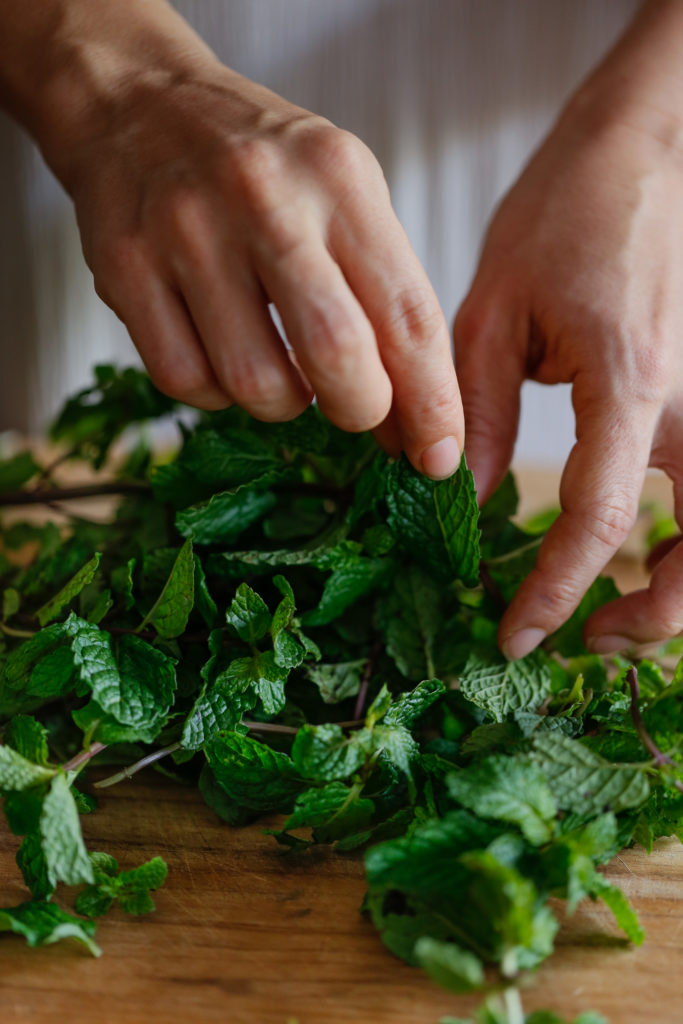This series celebrates the common herbs, because in a world of novelty – it’s easy to forget the benefits of the humble, accessible supermarket herbs for the skin, body, and mind.
And more importantly – the abundance of wellness you have access to.
Mint (Mentha x piperita)
Herbal Actions: Analgesic, Antispasmodic, Nervine, Antimicrobial

The refreshing aroma of mint definitely wakes you up – but mint actually has a calming effect on the body, and nervous system. It soothes and relaxes cramping muscles, tension and anxiety.
And this is true for all mints! Peppermint, spearmint, apple mint, chocolate mint… all different varieties of mint have been studied and found to have therapeutic effects…
Peppermint showed the greatest effect because it has the highest amount of menthol, which is responsible for that soothing, numbing, therapeutic action.
The Herbal Actions of peppermint – and how they work
PAIN & CRAMPING
As an analgesic and antispasmodic, mint offers relief from pain and muscle spasms. Studies have shown that applying peppermint essential oil on the skin helps to relieve itching and pain on the surface of the skin, and deep down into muscular and nerve tension. (ref)
Researchers found that it works because the menthol in peppermint affects Kappa Opioid receptors, which turn on pathways in the nervous system that inhibit pain and discomfort. Plus, it also increases the cell’s threshold for stimulation – so the sensation of pain isn’t as easily triggered. (ref) Makes me think of the practice of cold showers, you build up a resilience to stress…
The best way to use mint for itch and pain relief is to apply peppermint essential oil on the skin over skin irritations, bites and stings, aching muscles, menstrual cramps, upset stomach, and on forehead and temples for headaches. (ref)
Make a salve with peppermint infused oil, and add in peppermint essential oil at 2% dilution, for a more potent remedy. Use it as needed directly over the areas where you feel discomfort. Avoid eyes and mucus membranes.
Also, drink peppermint tea – for the same reasons and benefits.
It’s a great after-dinner drink, especially if you experience digestive issues, cramping, or bloating, you can also make a peppermint cordial or tincture. Add some peppermint to any digestive or menstrual tea blend, for those calming and soothing benefits. It also brightens and uplifts the flavor!
STRESS & ANXIETY
As a nervine, mint relaxes stress and anxiety. Especially when you notice you’re stuck in a negative mindset and ruminating thoughts.
The aroma of mint jumps up and grabs your attention. It lifts you out of a stressful mental state – and gives you the ability to breathe and reset. Peppermint has been studied in hospitals and found to soothe patient fear and anxiety before surgery, and also helps to relieve nausea after surgery. (ref) It’s good to have mint around – when you’re going through any form of physical and mental stress.
What’s happening is that the menthol in peppermint stimulates endorphins, the happy hormone that increases pleasure and reduces pain and discomfort. (ref) Your mood is uplifted – and then at the same time, it stimulates the hippocampus, which improves cognitive function and memory.
You’re able to focus your mind and think clearly. This is why peppermint is great to use during study and work.
You might also want to breathe in peppermint before making decisions – so that you’re in a relaxed, clear state of mind – and your cognitive functions are switched on!
It’s beautiful the way peppermint uplift your spirits and clears your mind, and at the same time, keeps your body calm and relaxed. The combination is a state of being that we all strive to feel: comfortable in your body, focused, and enjoying the present moment.
BACTERIA
As an anti-microbial, peppermint supports a healthy, balanced community of flora on the skin. It has antibacterial, antifungal, and antiviral properties – so it covers the bases!
When your skin is compromised (impaired), bacteria that ordinarily live on the skin with no issue – can create infection and inflammation, basically stress out your skin.
Congested pores can create an opening for bacteria to enter and cause havoc – activating your inflammatory responses and creating itchy, red, inflamed pus-filled bumps that we see as pimples. Usually, the bacteria responsible for this is Staph, which lives on the skin at all times.
And so, using antimicrobial herbs on the skin simply helps to support the skin and prevent opportunistic bacteria from proliferating and causing distress.
Peppermint is shown to have moderate effects against bacteria. It’s not our heaviest hitter in the herbal world and it’s hard to tolerate higher concentrations of peppermint on the skin. You could increase antibacterial activity in your skincare preparations by blending in other herbs like lavender, Thyme and Myrrh.
I feel that the greatest benefit of using peppermint for breakouts – is the relief from discomfort, itch, and pain that it provides.
Roundup: Ways that Mint can be useful in daily life
- Mint tea for digestion: Drink mint tea after dinner, or when you feel digestive discomfort.
- Mint aromatherapy for stress & focus: Use mint aromatherapy during work and study. Spritz it in the air to boost your concentration, and snap you out of distracting mental loops.
- Mint skin care for aches and pain: Make a mint balm to rub on your forehead when you feel tension headaches, on aching muscles, or on your abdomen to relieve cramps.
5 wellness products you can make with mint
- Mint Syrup
Make minty after dinner tonics, and cocktails to soothe your belly after a meal.
Or for anytime you feel digestive/menstrual discomfort.
Mint sryup recipe - Soothing Salve
A salve has a creamier consistency, that you can rub into aching muscles and cramping belly.
To make your salves, use peppermint infused oil + a 2% dilution rate of peppermint essential oil for therapeutic aromatherapy. You could even use this salve over your cheest when you feel congested.
Balm/Salve Guide – from the Infused Herbal Oil Workshop
- Mint Roller Ball
Rub on the temples when you have a headache, or over itchy bites and stings. You can also make a balm if you prefer that application. For the roller ball use peppermint infused jojoba oil or fractionated coconut oil with a 2% peppermint essential oil dilution.
10ml roller ball = 6 drops peppermint essential oil
You can use pure peppermint, or a good idea is to blend peppermint + spearmint
You can also blend other essential oils. Lavender + peppermint compliment eachother therapeutically for pain/stress - Mint Aroma Mist
Spritz in the air anytime you need a mental reset and boost. It’s great to have our computer, when you’ve been staring at a screen for too long! Becuase of the high amount of alcohol (needed to solubilze the essential oil) this spray is not for the skin – you can spray your clothes.
2oz spray bottle
1 part ethanol alcohol (high proof!)
36 drops of essential oil.
Its good to blend peppemint with other essential oils, so it’s not too sharp!
(I love 25 drops White fir + 11 drops peppermint) Sweet Orange is also great for stress! - Belly Soothe Tea
Make your own tea blend, something as simple as peppermint + ginger work together to soothe discomfort.
1 inch grated ginger root
2 cups of water
Bring to boil, then shut off the heat. Let sit for 10 minutes
Add peppermint leaves. Let it sit for another 5 minutes and then strain and drink.
